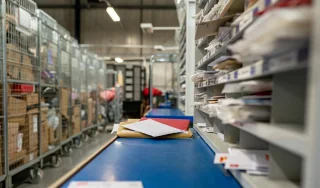Technology has transformed the modern office beyond all recognition in a dizzyingly short time frame. Today it’s hard to imagine that the widespread use of computers in offices dates back only to the late 1980s/early 1990s and that the World Wide Web was invented just 25 years ago. We’ve come a long way in the last quarter century – machine technology has greatly simplified workflow by handling routine daily tasks as well as processing data at speeds unimaginable to the human brain.
The way that businesses and offices handle their postage has been similarly transformed, with new technology speeding up handling and delivery times and improving efficiency on all fronts. The days of standing in line to buy stamps or wondering when – or if – a delivery would arrive are, thankfully, long gone. Let’s take a look at a few technological innovations that deliver great results for today’s office mailrooms and business postage services.
Franking machines. These handy devices – which print postage tariffs directly onto a mail item at a cheaper rate than using paper stamps – have been around since the late nineteenth century. However, today’s most advanced business models can process over 20,000 mail items per hour with virtually non-stop printing. Digital franking machines come in a range of sizes and capabilities for every type of business and often include built-in scales to precisely weigh letters and parcels prior to postage. As well as printing postage tariffs, franking machines can print marketing text, logos and other designs on mail items, making them a great advertising tool for businesses.
Folder Inserters. In the past, office workers had to fold mail contents by hand before inserting the pages into an envelope. This was a time-consuming and costly process and highly impractical for bulk mail requirements. Thankfully, technology has solved this problem with the advent of folder inserters. These are machines that automate the folding and insertion process between 10 and 40 times faster than by hand. As Royal Mail’s postage tariffs are based on size as well as weight, customers can make big savings by simply folding items and placing them in smaller envelopes. Offering a level of precision unmatched by the average mailroom worker, folder inserters ensure a professional presentation of mail through crisp folds, accurately collated inserts and correctly positioned addresses in each window envelope.
Mail tracking. Thanks to technological advances, it’s now possible to track the whereabouts and delivery status of a mail item at virtually every stage of the mailing process. Royal Mail has provided its postmen and women with 36,000 handheld mail tracking devices so that customers of its Royal Mail Tracked and Royal Mail Special Delivery Guaranteed services can have their mail items scanned as soon as they are delivered, even in remote locations. This gives customers real-time information on when their mail was delivered or is due to be delivered.
Mail analytics. Designed for high-volume customers of business, advertising and publishing mail, Royal Mail’s new Mailmark product incorporates the most sophisticated digital reporting technology to track bulk mail deliveries and analyse performance. Mailmark barcode technology allows web-based reporting using an online analytics dashboard. This provides detailed batch level reporting on everything from delivery time, volume and performance to item level error reporting. Customers can keep track of how much they are spending on postage using real time information, as well as make use of online data to improve performance, evaluate ROI and plan and coordinate mail campaigns more effectively.
We aren’t quite at the stage of replacing postmen and women with robots (although so-called ‘delivery drones’ are on their way!) but technology has certainly improved the speed, efficiency and cost performance of office mailing. If you’re relatively new to office life, you may have never licked a stamp in your life. Indeed, future generations may come to know of the humble postage stamp only from devoted philatelists!

